Quail are one of the smallest domestic birds, which allows their breeding to be possible in small areas like your home garden. Quail are known for their healthy, delicate meat, and while their eggs are very tasty, they are full of nutritional value too.
These little birds may be small in size, but they have plenty of character and can be fantastic egg-laying pets. Although certain quail species are capable of flight, they spend most of their time on the ground. They are less noisy than hens and can be kept in relatively small coops.
There are several different quail breeds, some are good for their meat or eggs, while others are simply lovely to keep as pets.
Quail are shy birds that like to dwell in flocks. I wouldn’t recommend keeping only one quail because the bird would get depressed without companionship. Four or five hens to one cock are the ideal ratio.
Read on if you want to know which quail breed is best for you.
Table of Contents
1. Coturnix Quail
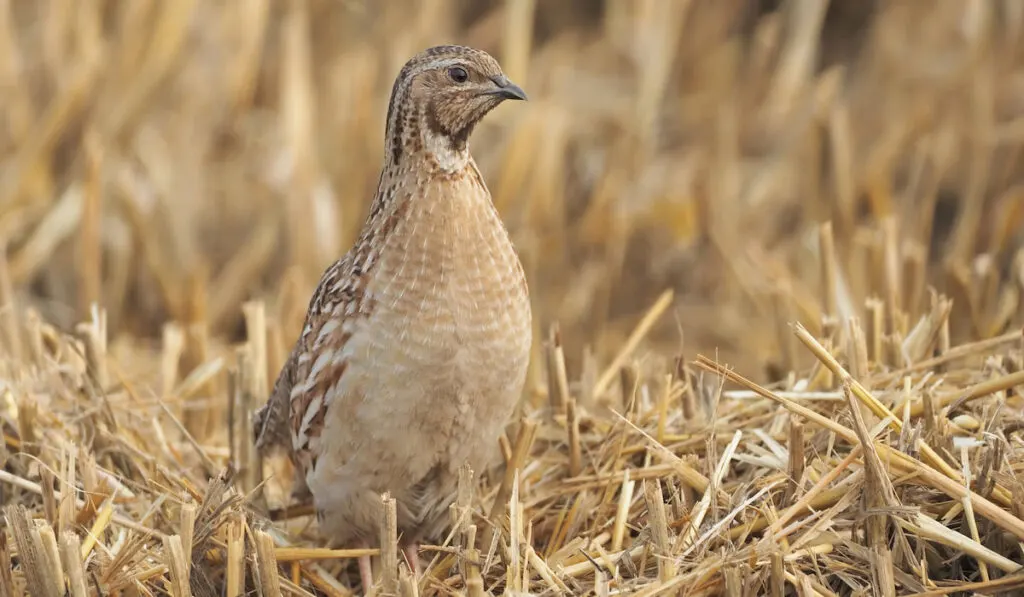
The domestication of Coturnix quail dates back to the eleventh century in Japan. Historically, they were kept as songbirds and used in bird singing contests.
The Coturnix quail, also called the Japanese quail, is a docile bird that can be raised in various conditions. Small to medium in size, depending on variety, Coturnix quail have a range of brown, white, and grey iridescent plumage, meaning that their colors seem to change when seen from different angles.
Coturnix quail come in a few different varieties:
- British Range
- Tuxedo
- English White
- Manchurian Golden
- Texas A&M
- Pharaoh
Despite their history as songbirds, today’s breeders typically rear these lovely quails for their eggs and meat rather than their singing abilities. Despite being small, quail’s eggs and meat are exceptionally nutritious and delicious.
Coturnix are the most profitable quail to raise for meat and eggs since they reach maturity after 6 to 8 weeks and begin laying eggs. With an average of 300 eggs laid annually, this quail has to be the best egg layer on the list.
Due to their versatility, this breed has gained popularity among backyard poultry growers.
They grow quickly, thrive in colder climates, require relatively little care beyond water, food, shelter, and safety, and are tolerant to being handled by humans.
Coturnix quail can fly, and while they prefer to scamper around on the ground, they should be kept in a quail pen. They won’t come back once they fly away.
Coturnix aren’t hard to tame and will respond positively to consistent, gentle handling when raised by people from an early age.
Due to its docile nature, the Coturnix quail is an excellent choice for a first-time quail pet owner.
Key Information:
- Uses: meat, eggs, and as a pet
- Temperament: docile, easy-going
- Size: Males 3.5 to 5 ounces. Females 4.2 to 5.6 ounces
- Color: A range of brown, white, and gray tones
- Price: Pharaoh varieties: Female Adult $48; Male Adult $20; Unsexed Chick $14; 6 Fertile Eggs $9.99
- Lifespan: 3 – 6 years
- Origin: Japan
2. King Quail
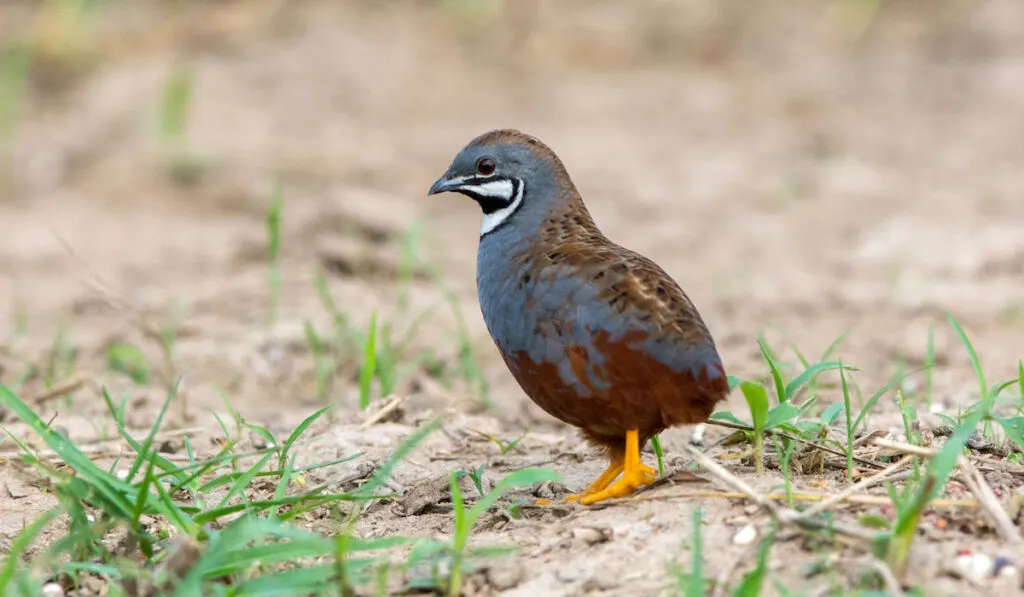
The King quail, also known as Button Quail, Chinese Blue Painted Quail, Blue-Breasted Quail, and Asian Blue Quail, is a stunning, decorative bird with iridescent plumage. Wild populations are found in several countries across Southeast Asia and Oceania.
You can raise King quail for their eggs and meat, but they only grow to about 5.5 inches in length and weigh under 2 ounces, so this relatively small bird doesn’t have much to offer in that regard.
King quail are social birds and require the company of other birds to survive. The suggested grouping is one male to two female King quail.
They respond well to affectionate care, although they aren’t necessarily fond of physical contact. They can run very fast, especially when threatened. They can also fly, if necessary, although not very high. They are quiet, busy birds that can be fascinating to observe.
King quails have short dark tails, black beaks, and dark red eyes. The chests of wild male King quails are bluish-gray, while their bellies are rusty red. They have black-framed white patches at the base of their throats, and their back and tail feathers typically have a mottled brown and black pattern.
The female King quail has a brownish tint with a silvery underside, and her tail feathers are a mottled brown and black.
Birds of this species are already quite colorful, but selective breeding in captivity brings out even more of their vivid plumage.
Key Information:
- Uses: Ornamental pets, hobby
- Temperament: friendly and active
- Size: Males 4.7–5.5 inches; Females 4.7–5.5 inches
- Color: Blue, brown, silver, black, red, white
- Price: Young 4 to 6-week-old birds cost about $10
- Lifespan: 13 years in captivity
- Origin: Asia
3. Blue-Scale Quail
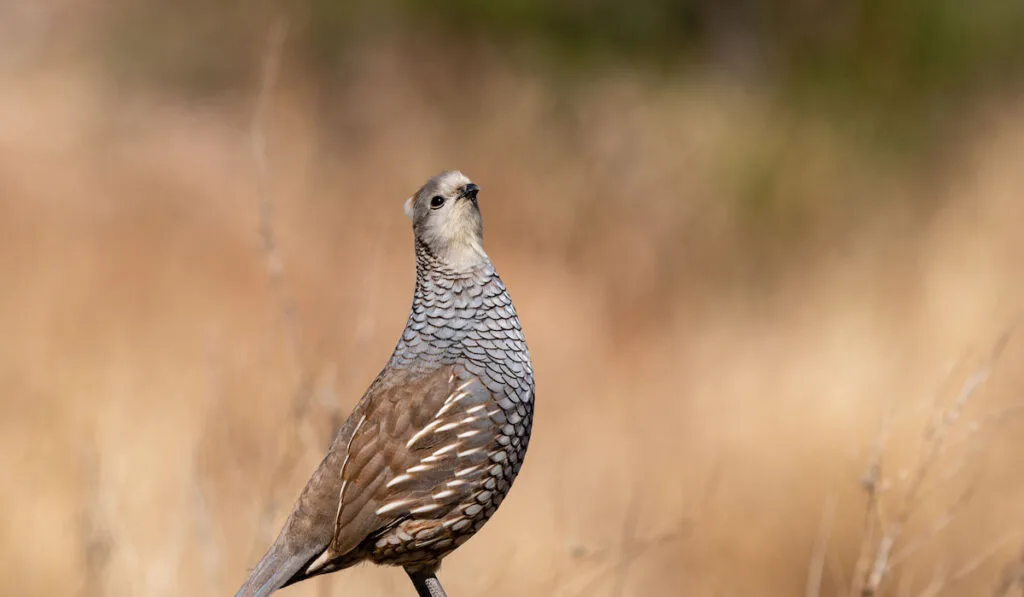
The Blue-Scaled quail is also known as the Blue quail, the Scaled quail, and the Cottontop quail. Arizona, Colorado, Kansas, Texas, New Mexico, and Oklahoma are just some places where you’re likely to encounter them in the southwestern United States.
Blue-Scaled quails are now a popular sport-hunting target and are raised in captivity for eggs and meat.
In the wild, they use their plumage to blend in with their environment. They are overly cautious and watchful and respond swiftly to any sign of danger. They maintain their alertness and instinct for survival even when housed around humans.
Though they are capable of great flight, Blue-Scaled quail frequently opt to run away rather than take to the air. On the run, they have a top speed of 15 mph and can promptly change direction or conceal themselves when necessary.
Many people keep Blue-Scaled quails as pets in captivity for pleasure. They have a peaceful temperament and get along well with a wide variety of different bird species.
They are also kept for their meat and eggs. Quail eggs are a delicacy due to their small size, unique appearance, and high nutritional value. A Blue-Scaled quail hen will lay 50 to 60 eggs per year, ensuring a consistent supply if you raise a flock.
Blue-Scaled quails are bluish gray, with the breast mottled with white. You will recognize them by the white feather crest that crowns their heads. Males and females look nearly identical, but males are just a little bigger on average than females.
As long as you keep them in conditions close to their natural habitat, they will do well. It’s best to keep the Blue-Scaled quail in a separate coop from other quail species throughout the breeding season in case you’re keeping more than one species of quail.
Key Information:
- Uses: Pets and hobby as well as eggs production
- Egg Production per year: 50 – 60
- Temperament: peaceful, extremely cautious, and watchful
- Size: Females 6 – 8 ounces; Males 6 – 8 ounces
- Color: Gray, brown, blue, white
- Price: A pair 6 to 8 months old costs around $295.00
- Lifespan: 5 – 7 years in captivity
- Origin: Southwestern United States
4. Mountain Quail

Mountain quails are the largest breed of quail in the United States and are found in the mountains in the western United States.
Mountain quails have an attractive coloration with plumage in shades of brown, blue, gray, white, and black. Their identifying feature is the two feathers that rise and curve upward from their crowns. It’s hard to differentiate males from females.
Although they have wings, Mountain quails usually prefer to remain on the ground, where they conceal themselves more easily.
The Mountain quail nests in the spring and raises its young together with its spouse from March to June.
People hunt Mountain quail for their meat, but they also breed them on farms for their eggs and meat. There is a growing trend of keeping these stunning birds only for their aesthetic value.
Keeping Mountain quail might be difficult due to their requirements, but they can thrive with skilled keepers who understand their specific needs.
These birds are not recommended for beginner bird owners.
Key Information:
- Uses: Ornamental pets
- Egg Production: 9–15 eggs per season
- Temperament: Mountain quails might be aggressive and difficult to breed
- Size: Females 9.2 pounds, Males 6.7 ounces
- Color: Olive, brown, blue, gray, white, black
- Price: An adult pair costs around $455.00
- Lifespan: 3–6 years
- Origin: Western North America
5. California Quail
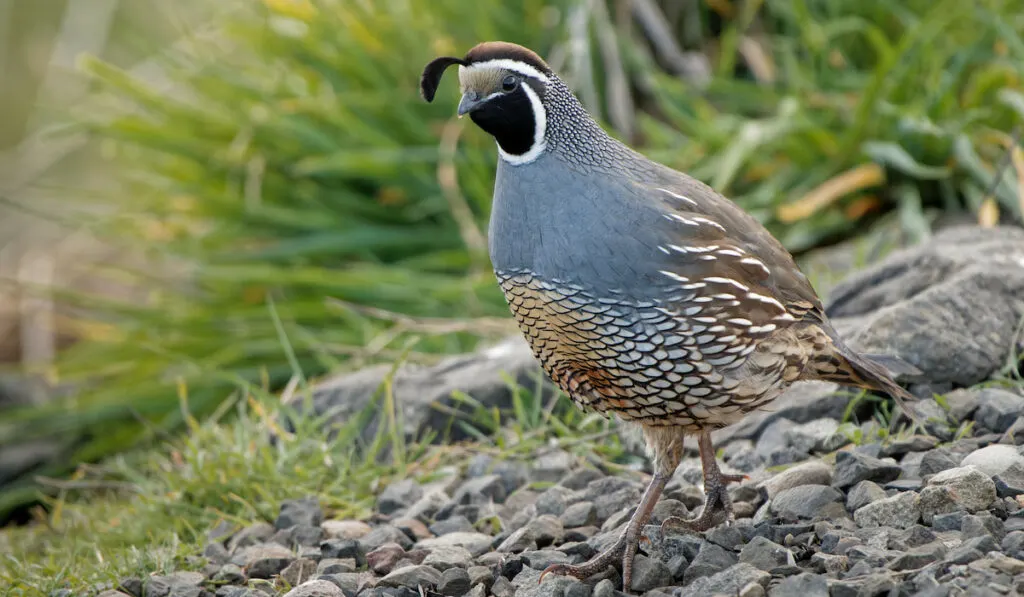
The California quail is a forest bird that lives in the southwestern United States and northern Mexico.
The male and female California quail have a unique white, cream, and chestnut pattern on their underbellies. As they mature, adult males take on a darker gray and brown coloration with black facial markings. Females are a plainer brown and lack distinguishing facial characteristics.
Most of the time, California quails can be found scouring and scraping the ground for food, but when attacked by predators, this small bird can run as fast as 12 miles per hour.
People value their meat since it is both healthy and tasty. The western states of California, Nevada, Oregon, and Washington all permit the sport hunting of California quail.
Even though they don’t produce as many eggs as chickens, farmers highly value these birds for the quality of their eggs. However, most captive California quail birds are kept as pets for their visual appeal.
In addition, California quail are beautiful songbirds with impressive musical abilities. Both males and females make pleasant chirps that blend to create an original tune.
Even though California quail aren’t exactly pets, their friendly nature and colorful feathers make them great companions for bird lovers.
Key Information:
- Uses: Ornamental pets
- Egg Production: 12 – 16 eggs per year
- Temperament: quite tolerant of people
- Size: Females 5 – 5 pounds, Males 6 – 7 ounces
- Color: Olive, brown, blue, gray, white, black
- Lifespan: 1 – 4 years
- Origin: southwestern United States and northern Mexico
6. Gambel’s Quail
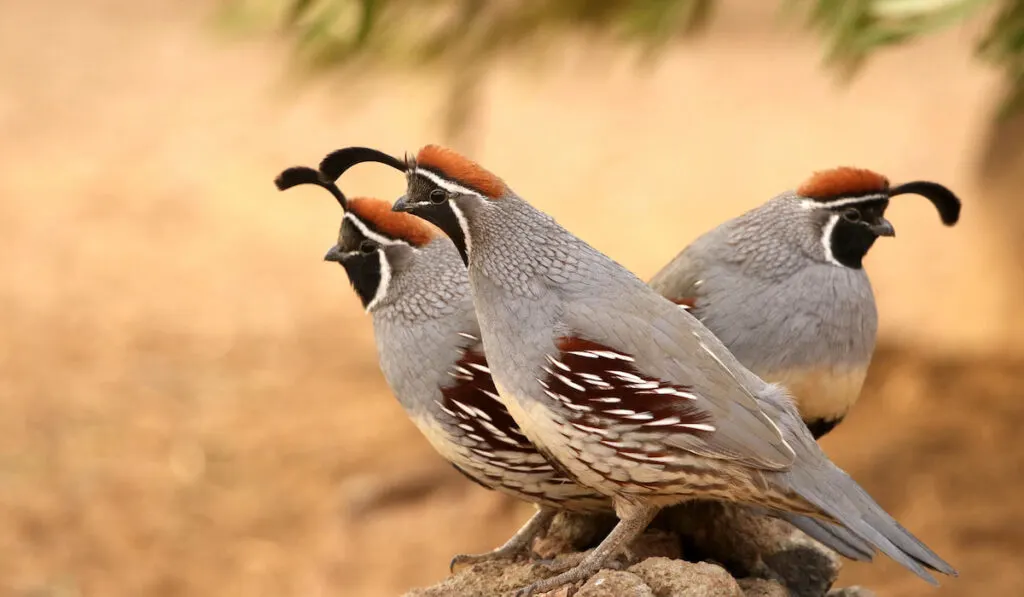
The Gambel’s quail was first discovered in the United States. Quails of this species are commonly found in the southern California and northern Mexico deserts.
The Gambel’s quail has a lovely camouflage pattern in shades of gray, brown, and cream. A male will have a bright red hat, brown sides with white stripes, and a white belly with a black patch. The females are duller in color and lack the bright markings on the males’ heads.
The stunning Gambel’s quail is a friendly bird that rarely takes to the air. Groups of Gambel’s quails consist of a dozen or more little birds and are often seen scurrying around the ground.
Keeping Gambel’s quails as pets or in aviaries is possible, but only if these quails are not kept in a group with other quails. Other quail species, as well as other ground-dwelling birds, may be attacked by Gambel’s quails.
Key Information:
- Uses: Ornamental pets
- Egg Production: 10 – 12 eggs per year
- Temperament: they can be aggressive towards birds of other species
- Size: from 5.1 to 6.5 ounces
- Color: brown, gray, white, black, and bright red hat on males
- Lifespan: 5 years in captivity
- Origin: southwestern United States and northern Mexico
Final Thoughts
If you want to get into bird breeding but don’t have a lot of room, quail farming is a fun hobby you might try.
Quail eggs are highly regarded for their nutritional value, and quail meat is praised for its exceptional tenderness and rich flavor.
However, many people keep quails just for their aesthetic value and the thrill of witnessing such a beautiful bird.
Resources
- https://en.wikipedia.org/wiki/Coturnix;
- https://www.motherearthnews.com/homesteading-and-livestock/coturnix-quail-zmaz81sozraw/;
- https://petkeen.com/coturnix-quail/;
- https://backyardpoultry.iamcountryside.com/poultry-101/coturnix-quail-farming-tips/;
- https://en.wikipedia.org/wiki/Coturnix;
- https://www.heritageacresmarket.com/coturnix-quail/;
- https://www.sugar-feather.com/product/pharaoh-coturnix-quail/
- https://animaldiversity.org/accounts/Coturnix_chinensis/;
- https://www.swifft.net.au/cb_pages/sp_king_quail.php;
- https://petkeen.com/king-quail/;
- https://www.heritageacresmarket.com/button-quail/;
- https://www.louiesaviary.com/button-quail.html
- https://www.purelypoultry.com/blue-scale-quail-p-1082.html;
- https://www.allaboutbirds.org/guide/Scaled_Quail/overview#;
- https://abcbirds.org/bird/scaled-quail/;
- https://petkeen.com/blue-scale-quail/
- https://www.allaboutbirds.org/guide/Mountain_Quail/overview;
- https://petkeen.com/mountain-quail/;
- https://www.purelypoultry.com/index.php
- https://petkeen.com/california-quail/;
- https://www.allaboutbirds.org/guide/California_Quail/id#
- https://www.allaboutbirds.org/guide/Gambels_Quail/id;
- https://www.allaboutbirds.org/guide/Gambels_Quail/overview;
- https://animaldiversity.org/accounts/Callipepla_gambelii/;
- https://petkeen.com/gambels-quail/;
- https://www.desertmuseum.org/kids/oz/long-fact-sheets/gambel
